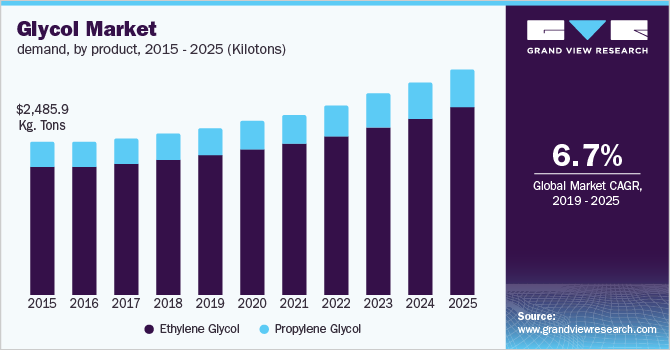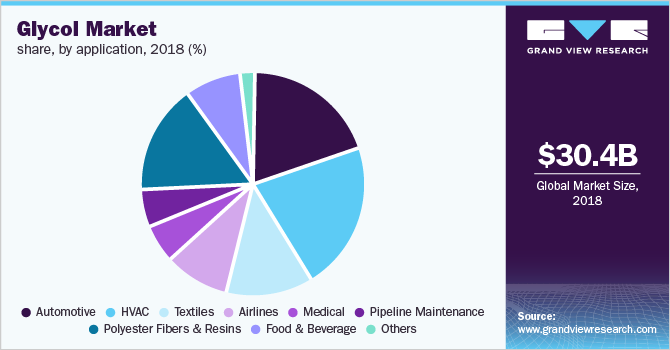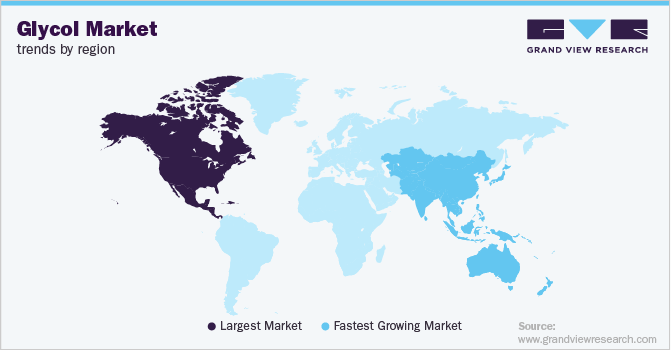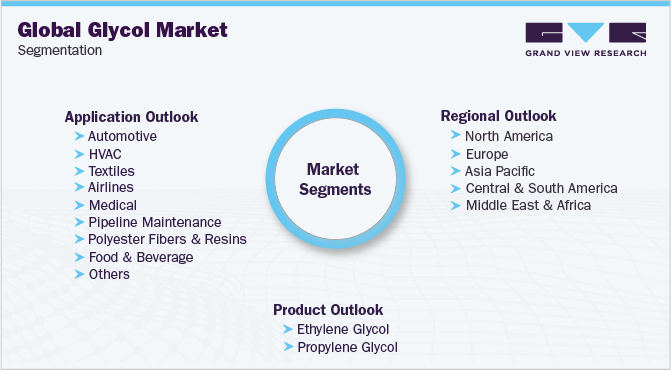- Home
- »
- Petrochemicals
- »
-
Glycol Market Size, Share & Trends Report, 2025GVR Report cover
![Glycol Market Size, Share & Trends Report]()
Glycol Market (2019 - 2025) Size, Share & Trends Analysis Report By Product (Ethylene, Propylene), By Application (Automotive, HVAC, Textiles, Polyester Fibers & Resins, Airline), And Segment Forecasts
- Report ID: GVR-1-68038-402-4
- Number of Report Pages: 102
- Format: PDF
- Historical Range: 2014 - 2017
- Forecast Period: 2019 - 2025
- Industry: Bulk Chemicals
- Report Summary
- Table of Contents
- Segmentation
- Methodology
- Download FREE Sample
-
Download Sample Report
Report Overview
The global glycol market size to be valued at USD 47.26 billion by 2025 and is expected to grow at a compound annual growth rate (CAGR) of 6.7% during the forecast period. Derivatives of glycol are used across a wide range of sectors that include automotive & transportation, food & beverage processing, heating, ventilation and air conditioning (HVAC), and polyester fibers. The recent turnaround in the economic outlook of western markets, as a result of recovering manufacturing activities, has led to a positive impact on the growth of the market.
During the time of increased regulatory oversight, glycols have come under the intense scrutiny of agencies, such as the U.S. EPA and FDA, regarding their detrimental effects on human health. Though propylene glycol is classified as generally recognized as safe (GRAS) by FDA, the agency has stipulated acceptable daily intake levels to protect human health. Similarly, studies have been conducted by EPA regarding the toxicology profile of glycols and prescribed recommendations for handling and usage of these chemicals.

Regulations, as stated above, cast a critical role in the industry’s dynamics, wherein compliance procedures, inventory protocols, and manufacturing standards evolve based on changes to existing policies. Such intervention at state-levels also gives rise to a greater emphasis on the development expenditures of companies, which are generally dominated by changing customer preferences and product standards.
Across the chemicals industry, there is an evident effort by companies to improve the efficiency of supply channels and reduce uncertainties associated with cost components. As the world opened-up to virtual marketplaces, the chemical sector has also caught up with the trend. Various online platforms, these days, sell chemicals (including glycols) to end-users through such portals.
From a consumer’s perspective, a virtual marketplace provides ease of procurement. Whereas, from a vendor’s perspective, costs associated with physical infrastructure can be reduced by marketing their products online. For the market, this trend has been instrumental in improving the profit margins of companies and also broadens their customer base without vying for a physical presence in foreign markets.
Glycol Market Trends
Glycol is used in various industries and its cooling capabilities aid in completing numerous activities. The organic property of glycol has significantly influenced the recent rise of the global market. The usage of ethylene glycol in HVAC has emerged as a significant driver of the global glycol market.
Advanced technologies in the packaging market are forecast to increase the variety of food product applicability, comprising refrigerated, chilled, shelf-stable, microwaveable, and prepared mixes. Average spending on personal care and sanitary items such as moisturizers and sunburn creams is driving global market expansion.
The market's growth is being restricted by volatility in the supply and prices of raw materials such as ethylene, ethylene glycol, and acetaldehyde. Oil price volatility is further restricting the market growth.
Increased demand for glycol in the automotive industry is expected to boost global market growth. As it has a considerably lower melting point than water, ethylene glycol keeps vehicle engines from freezing in the winter and functions as a coolant to avoid overheating in the summer. Furthermore, ethylene glycol is used in automobiles to absorb combustion heat, providing adequate opportunity for the global market.
Product Insights
The market, based on the product, has been classified into propylene glycol (1,2-propanediol) and ethylene glycol (1,2-ethanediol). These products cater to a diverse range of application sectors. Propanediol is widely used in the manufacturing of polyester compounds and as a solvent, the chemical is used for food coloring, flavoring, paint dispersions, and plastic resin manufacturing.
Due to its inherent low toxicity, propylene glycol has been gaining traction as a substitute for ethylene glycol in antifreeze applications. As an antifreeze, 1,2-propanediol has found usage in the chemicals, food, and pharmaceutical sectors. However, as a substitute to ethylene glycol, the chemical in a 40:60 ratio of 1,2-propanediol: water has found greater utilization as an environment-friendly automotive and marine antifreeze.
Ethylene glycol is widely used as an antifreeze, coolant, and heat-transferring agent. In addition to its ability to bring down the freezing point of fluids, the chemical also functions as a reagent in the production of polyesters, alkyd resins, synthetic waxes, and explosives. Furthermore, the ethylene-based glycols also find usage as an ingredient in printing inks, paint solvents, and hydraulic fluids.
Application Insights
Key industry sectors catered by the market include automotive, polyester fibers & resins, pharmaceuticals, food & beverage processing, pipeline maintenance, textiles, aviation, medical, and HVAC. The post-recession economy of the world underwent structural changes in terms of trade policies, business localization & sustainability, and fiscal mechanisms.
As of 2018, the global GDP expanded by nearly 3.7%, as industrial activities recovered across developed nations and evolved considerably across developing parts. This growth in the global economy shaped a promising future for glycol manufacturers. Automotive will be the fastest-growing application segment during the forecast period.

Globally, automotive production grew by 2.4% and reached 97.3 million units in 2017, with a few European countries, including Netherlands, Finland, Portugal, Slovenia, Russia, and Ukraine, registering double-digit growth rates. Europe maintains a dominant role in glycol demand, positive macro indicators, as stated above, should be a source of optimizing the glycol industry’s growth forecast.
Regional Insights
North America and Europe have traditionally been the powerhouse of manufacturing technologies and innovative approaches to build industry ecosystem. Although these regions collectively accounted for nearly 50.0% of the global demand, the market has witnessed a large shift in production landscape towards Asian markets with China positioning itself as a regional as well as a global hub for manufacturing.

In 2018, Asia Pacific accounted for nearly 43.0% of the global mono ethylene glycol (MEG) production capacity and 44.0% of the global consumption. In terms of production, China, India, and Taiwan led the region. In terms of consumption, China and India together accounted for nearly 85.0% of the regional demand and are characterized by the presence of huge consumer base and export-oriented industrial production.
Key Companies & Market Share Insights
There exists a high level of competition among players as a result of surging demand for glycols across various industries. High opportunities present in developing nations have led to the establishment of regional small-scale players, while numerous glycol recovery companies have surfaced across North America.
The global market is highly product-driven, with market participants investing a large amount in developmental activities and commercializing products with improved specifications. A few notable companies operating in the market include DowDuPont, BASF, Sinopec, Royal Dutch Shell, Lotte Chemical, Ashland, Cargill, Univar, AkzoNobel, SABIC, Huntsman, Reliance Industries, and LyondellBasell.
Recent Developments
-
In September 2021, INEOS Oxide received EXCiPACT accreditation for pharmaceutical excipients for ethanolamines manufactured in Plaquemine, Louisiana, USA. The certification ensures that all components of quality management systems meet GMP requirements as stated in the 2017 EXCiPACT for Pharmaceuticals Excipients. This achievement contributes to securing and supporting specialist product sales that require a high level of quality confirmation.
-
In August 2021, BASF and SINOPEC expanded its Verbund site, which is run by BASF-YPC Co., Ltd., a 50-50 partnership of the two businesses in Nanjing, China. It comprises the enlargement of targeting multiple chemical plants, including constructing the new tert-butyl acrylate factory to accommodate the growing Chinese market.
Glycol Market Report Scope
Report Attribute
Details
Market size value in 2019
USD 31.97 billion
Revenue forecast in 2025
USD 47.26 billion
Growth rate
CAGR of 6.7% from 2019 to 2025
Base year for estimation
2018
Historical data
2014 - 2017
Forecast period
2019 - 2025
Quantitative units
Volume in kilotons, revenue in USD million & CAGR from 2019 to 2025
Report coverage
Revenue forecast, company ranking, competitive landscape, growth factors, and trends
Segments covered
Product, application, region
Regional scope
North America; Europe; Asia Pacific; Latin America; Middle East & Africa
Country scope
U.S.; Canada; Mexico; Germany; France; U.K.; China; India; Japan; Brazil
Key companies profiled
DowDuPont; BASF; Sinopec; Royal Dutch Shell; Lotte Chemical; Ashland; Cargill; Univar; AkzoNobel; SABIC; Huntsman; Reliance Industries; LyondellBasell
Customization scope
Free report customization (equivalent to up to 8 analysts working days) with purchase. Addition or alteration to country; regional & segment scope.
Pricing and purchase options
Avail customized purchase options to meet your exact research needs. Explore purchase options
Global Glycol Market SegmentationThis report forecasts volume and revenue growth at global, regional, and country levels and provides an analysis of industry trends in each of the sub-segments from 2014 to 2025. For the purpose of this study, Grand View Research has segmented the global glycol market report on the basis of product, application, and region:

-
Product Outlook (Volume, Kilotons; Revenue, USD Million, 2014 - 2025)
-
Ethylene Glycol
-
Monoethylene Glycol (MEG)
-
Diethylene Glycol (DEG)
-
Triethylene Glycol (TEG)
-
-
Propylene Glycol
-
-
Application Outlook (Volume, Kilotons; Revenue, USD Million, 2014 - 2025)
-
Automotive
-
Auto Retail
-
Auto Traditional
-
Heavy-duty
-
Specialty Applications
-
-
HVAC
-
Textiles
-
Airlines
-
Medical
-
Pipeline Maintenance
-
Polyester Fibers & Resins
-
Food & Beverage
-
Others
-
-
Regional Outlook (Volume, Kilotons; Revenue, USD Million, 2014 - 2025)
-
North America
-
U.S
-
New England
-
Mid-Atlantic
-
East North Central
-
West North Central
-
South Atlantic
-
East South Central
-
West South Central
-
West
-
-
Canada
-
Mexico
-
-
Europe
-
Germany
-
France
-
U.K.
-
-
Asia Pacific
-
China
-
India
-
Japan
-
-
Central & South America
-
Brazil
-
-
Middle East & Africa
-
Share this report with your colleague or friend.
Need a Tailored Report?
Customize this report to your needs — add regions, segments, or data points, with 20% free customization.

ISO 9001:2015 & 27001:2022 Certified
We are GDPR and CCPA compliant! Your transaction & personal information is safe and secure. For more details, please read our privacy policy.
Trusted market insights - try a free sample
See how our reports are structured and why industry leaders rely on Grand View Research. Get a free sample or ask us to tailor this report to your needs.










